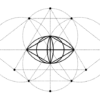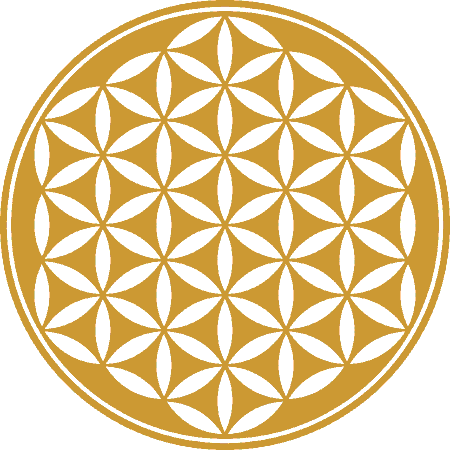
Next to the Seed of Life, the Flower of Life is one of the most powerful Sacred Geometry symbols. And just like the Seed of Life, it has many hidden meanings and secrets within its intricate design. In this article, let’s explore these hidden meanings and understand this beautiful and mysterious symbol from a deeper perspective.
What does the Flower of Life symbolize?
Similar to the Seed of Life, the Flower of Life represents creation, interconnectedness, unity, oneness, duality, the cycle of life, and the union of divine masculine and feminine energies.
Many believe that this powerful symbol contains within it the very blueprint of the universe. This symbol is also believed to contain the Akashic Records, a cosmic database of knowledge that reveals the secrets of all living things. Meditating upon this symbol is believed to expand your consciousness and give you access to this universal knowledge.
Some even believe that the Flower of Life has the power to deflect negative energies and promote healing on a spiritual level.
Whether you are seeking spiritual guidance, artistic inspiration, or simply looking to expand your knowledge about the creation of the universe, the Flower of Life has the potential to lead you on a transformative journey of self-discovery and wonder.
Flower of Life – Historical Significance

The Flower of Life is an ancient symbol that has been discovered across numerous cultures in various places. From the Temple of Osiris in Abydos, Egypt, where the oldest known examples of the Flower of Life can be found, to the Palace of Ashurbanipal in Assyria, to the Forbidden City and various temples in China, and the ancient city of Preslav in Bulgaria, this symbol has been etched into some of the most historical and impressive structures of the world.

Even today, the Flower of Life can be found in many spiritual places such as the Golden Temple in India, various temples in Japan, and Cordoba’s ‘la Mezquita Mosque’ in Spain. Here are just a few places where the Flower of Life has been found:
- Egypt – Temple of Osiris in Abydos, Temple of Karnak, and Luxor.
- Assyria – Palace of Ashurbanipal.
- China – Forbidden City in Beijing and the Yungang Grottoes in Shanxi province.
- Bulgaria – Ancient city of Preslav in Bulgaria, which was the capital of the First Bulgarian Empire from 893 to 972 AD. The symbol is depicted on a stone relief in the walls of the ruins of the royal palace.
- Israel – Ancient synagogues in Galilee and Masada.
- Japan – Various temples and shrines in Japan, particularly in the Shinto tradition.
- India -The Harmandir Sahib (Golden Temple) in Amritsar, the Buddhist temples in Ajanta, and the ruins of the ancient city of Hampi.
- Turkey – Ancient sites and buildings in the City of Ephesus.
- Italy – Several ancient buildings and works of art in Italy, including churches, cathedrals, and other religious structures dating back to the Middle Ages.
- Spain – Mezquita de Córdoba (Mosque-Cathedral of Córdoba).
- Middle East – Various ancient Islamic mosques.
Did you know that even Leonardo da Vinci was fascinated by the Flower of Life? He not only studied the complete Flower of Life design but also its various components, such as the Seed of Life. From these studies, he drew geometric figures such as platonic solids, spheres, tori, and more.
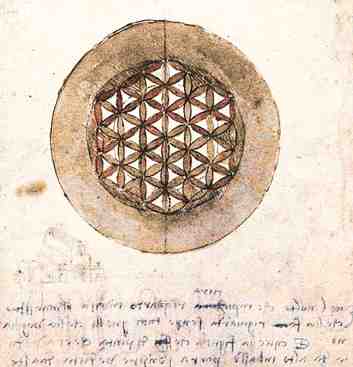
Interestingly, he even incorporated the golden ratio of phi into his artwork, which is derived from the Flower of Life design. This goes to show that the Flower of Life is not only a spiritually significant symbol but also a versatile and profound source of inspiration across various fields of study.
Creation of the Flower of Life
It’s fascinating to study the creation of the Flower of Life as it helps you understand the basis of creation of this universe!
The Flower of Life is built upon the Seed of Life pattern. The Seed of Life contains a total of 7 overlapping circles with one circle at the center and 6 circles surrounding it. The circle at the center represents Source, or Consciousness.
The Flower of Life is created by adding 12 additional circles to the Seed of Life as shown in the image below. Hence the Flower of Life contains a total of 19 circles.

The Flower of Life is generally depicted as surrounded by two outer circles as shown in the image below.

The following image shows the entire development process of the Flower of Life starting from a single Circle to the 7-circled Seed of Life and finally, 19 circled Flower of Life. To know about this creation process in detail, you can read this article on the Seed of Life.

In this article, we’ll take a brief look at the fascinating process behind the creation of the Flower of Life. Understanding this process can provide you with valuable insights into how the universe might have been created. So let’s see what the steps are.
Steps to create the Flower of Life
In beginning there was nothingness or an eternal void. The first form to come into existence from this void of nothingness was a dot. You can call this dot, Spirit, or Source. Now the dot (spirit) decides to expand its consciousness and hence it forms a circle. This circle represents the all-encompassing consciousness that is ever-present, with a complete 360-degree circumference.

To gain knowledge of itself, the Spirit decides to replicate itself and forms a second circle. Both circles remain connected in such a way that the circumference of one runs through the center of the other. This is known as the Vesica Piscis (as shown in the image below). This marks the formation of the world of duality or polarity.

The Spirit then divides itself five more times to create the Seed of Life – the very foundation of creation.

The Seed of Life contains 7 circles that include a middle circle (source) with 6 circles surrounding it. The circumference of all 6 circles runs through the center of the middle circle. This indicates that everything is connected to the source and contains the source within it. This also represents interconnectivity, unity, balance, and the concept of As Above, So Below.
The Seed of Life gives rise to the Flower of Life, which encompasses all forms and patterns of the universe within it. As discussed, the Flower of Life is formed by adding 12 additional circles to the Seed of Life.
The creation of the Flower of Life is therefore the story of the creation of the universe itself – a truly fascinating concept, don’t you think?
Symbols within the Flower of Life
The Flower of Life is the blueprint of the physical universe. It represents the underlying pattern present within all forms in existence. And not surprisingly, the Flower of Life contains within it as many as 15 symbols associated with creation and the world of form.
These symbols include the Vescia Piscis, Triquetra, Seed of Life, Fruit of Life, Metatron’s Cube, 5 Platonic Solids, Chakras, and the Labyrinth.
The following image illustrates all the symbols contained within the Flower of Life.

6 Hidden Meanings associated with the Flower of Life symbol
1. Flower of Life & Numerology
The Flower of Life contains a total of 19 circles. Adding the numbers 1 and 9 gives you 10. And adding this further, you get the number 1. Number 1 in numerology represents new possibilities, movement, change. balance, creativity, independence, and consciousness. It also represents the Sun, the source of all energy and life on Earth.
One is also the number of creation as it is from one that all other numbers spring forth. If zero represents the void or formlessness, 1 represents the dot or the first form from which everything came about. Thus 1 symbolizes the source in its physical form.
In Hinduism, the number 1 represents the Cosmic Womb also known as Hiranyagarbha (in Sanskrit).
Thus even from a numerological perspective, the Flower of Life represents creation, creativity, and source energy.
2. Flower of Life & the Seven Chakras
As per the Vedas (sacred Hindu texts), the human body has 7 major energy centers that run along the spine. These energy centers are known as Chakras (in Sanskrit). The word Chakra translates to Wheel, Circle, or Disk. The Chakras are believed to carry Prana (Chi or energy) throughout the body.
Interestingly, all seven chakras (energy circles) fit perfectly within the Flower of Life as shown in the image below.
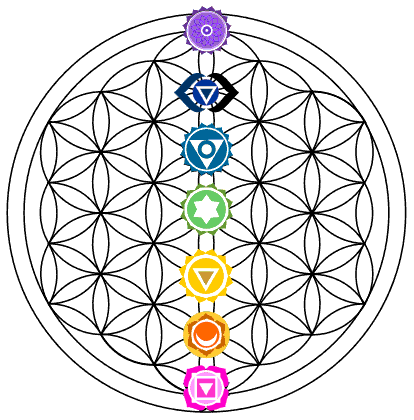
In addition, the heart chakra is located in the central circle of the Flower of Life. The central circle represents the Source or portal between the spiritual and material worlds. Similarly, the heart charka is your own energetic center where the physical and spiritual meet. You can connect with your inner being and higher spiritual realms via this center.
3. Fruit of Life within the Flower of Life
As we expand the Flower of Life by adding 34 more circles we get a total of 61 interlocked circles. Within this new pattern, the Fruit of Life reveals itself as shown in the image below.
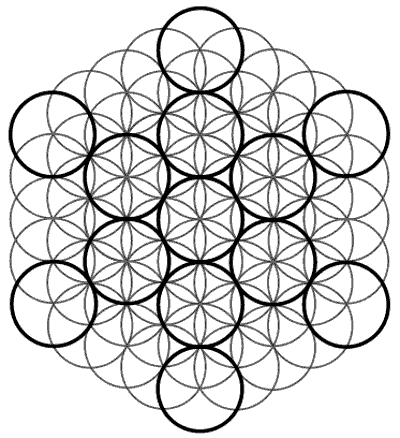
The Fruit of Life contains a total of 12 circles plus one circle in the middle that represents the source. The Fruit of Life is considered the base of the universe and believed to contain within it the basic structure of all atoms, molecules, and life in general. It also contains within it the Metatron’s Cube which contains all the five platonic solids. The platonic solids are believed to be the building blocks of the universe.
The Fruit of Life is also seen as a symbol of fertility and abundance, representing the potential for growth, creation, and nourishment.
4. Metatron’s Cube within the Fruit of Life
The Fruit of Life contains only circles and hence represents feminine energy. When we interconnect the centers of all the circles with each other using straight lines, we get the Metatron’s Cube (as shown in the image below). The straight lines here represent masculine energy. When these opposing energies unite, it leads to creation. Thus Metatron’s cube represents the balance, interconnection, and harmony that exists between these opposing forces that is crucial for creation to occur.
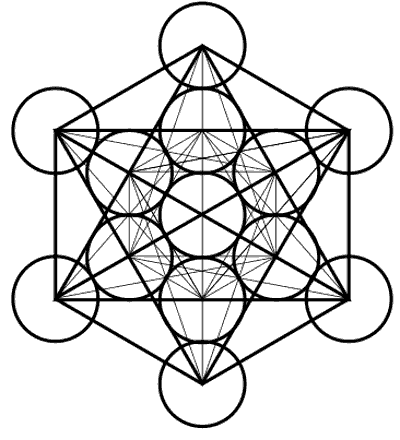
What’s interesting about the Metatron’s Cube is that it contains various geometric shapes embedded within it, particularly, the five platonic solids as shown in the image below.
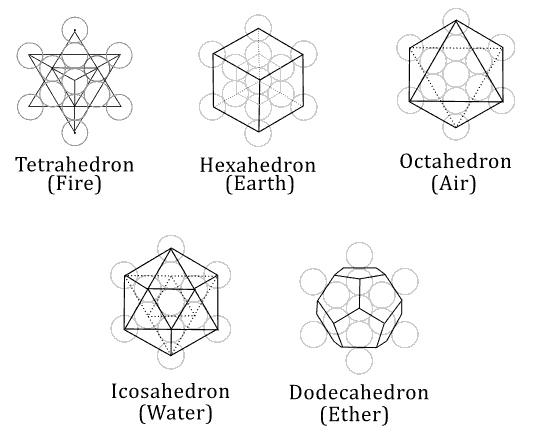
The five Platonic solids found within Metatron’s cube are as follows:
- Tetrahedron – contains 4 equilateral triangles and represents Fire
- Octahedron – contains 8 equilateral triangles and represents Air
- Icosahedron – contains 20 triangles and represents Water
- Hexahedron – contains 6 identical squares and represents Earth
- Dodecahedron – contains 12 pentagons and represents Ether
The platonic solids are named so because they were discovered by Plato sometime around 350 BC.
Now the Platonic solids are very special geometric shapes. For one, these solids are all of the same length, same face size, and same angles. In addition, the vertices of all shapes fit perfectly within a sphere.
The five platonic solids are also believed to represent the five elements (fire, water, earth, air, and ether) which are the building blocks of the universe. This is because it is only by the combination of these five elements that creation happens.
The Platonic solids are also believed to be the building blocks of organic life and the basis of all physical forms in the material world. They are found in everything from minerals, sound, music, and DNA molecules to snowflakes and microorganisms. Also, it has been found that every element of the periodic table has a geometrical connection with one of the platonic solids.
As you can see, Metatron’s Cube holds within it, important information about the very creation of the universe.
5. Flower of Life & the Labrinth

As shown in the image below, the Flower of Life contains within it the symbol of a Labrinth.
The labyrinth is an ancient symbol that represents the spiritual journey of self-discovery, leading from the material world to a connection with one’s inner self. It also represents creation and the journey of life. The labyrinth’s center represents the source of creation, while the labyrinth itself represents the soul’s journey in the material world. The soul must eventually return to the source only to be reborn and start the journey again. Walking the labyrinth can be considered a metaphor for spiritual transformation and growth.
6. Flower of Life & Kabbalah Tree of Life

The Flower of Life also contains within it the Kabbalah Tree of Life (as shown in the image below).
The Kabbalah Tree of Life contains 10 or 11 circles (known as sefirot) and twenty-two straight lines (or paths) that connect them together to form a pattern that resembles a tree. Each sefirot represent different aspects of the divine and the universe, such as wisdom, understanding, and beauty.
The top circle represents the source or divine and the bottom circle represents the material world. As such, the Tree of Life acts as a blueprint following which one can reach the divine while in the material world. It also represents the descent of the divine into the manifest world.
Many believe that this is an ancient pagan symbol that was later adapted into the Kabbalah. The Tree of Life is used as a tool for contemplation and meditation, and as a way to understand the nature of God and the universe.
Conclusion
The Flower of Life is a powerful symbol of creation, unity, balance, and interconnectedness. It acts as a portal to a deeper understanding of how the universe works and the intricate connection between everything that exists. Meditating on this symbol can help bring more calmness, and balance into your life while also expanding your consciousness and opening your chakras. It can also lead you to profound realizations about the universe and your place in it.
This symbol is a also beautiful reminder of the interconnectedness of everything in the universe and serves as an inspiration to live in harmony with all that exists. To tap into its power, consider drawing the symbol and using it as a tool for meditation. You can also use it to diffuse harmful frequencies and incorporate it as a symbol in your everyday life, to awaken your spiritual self.






